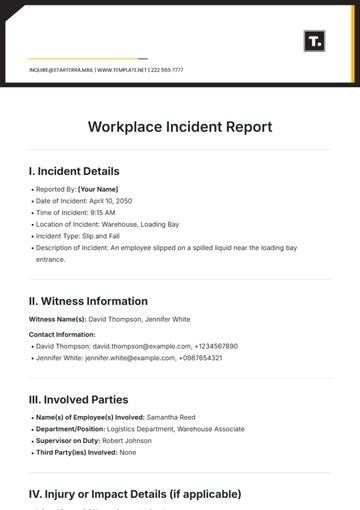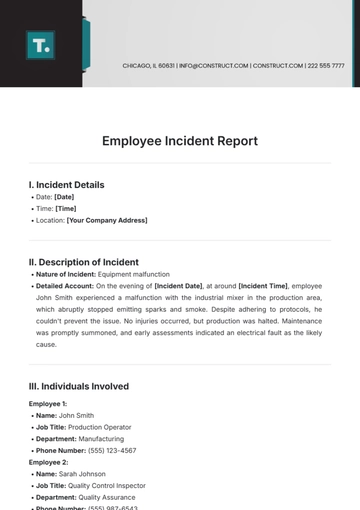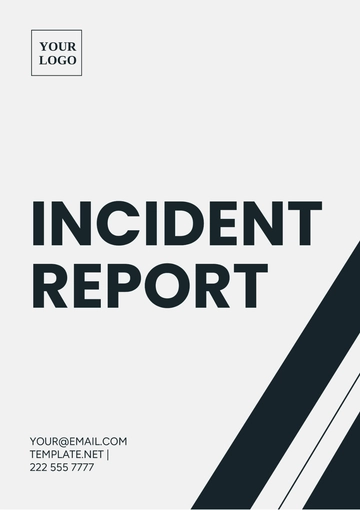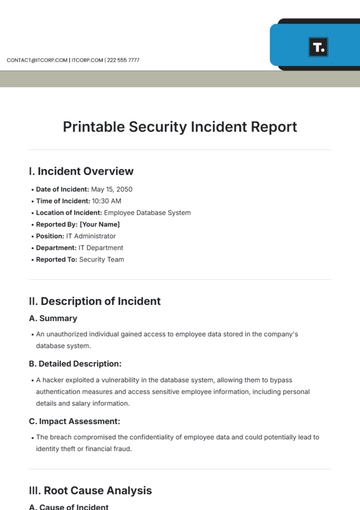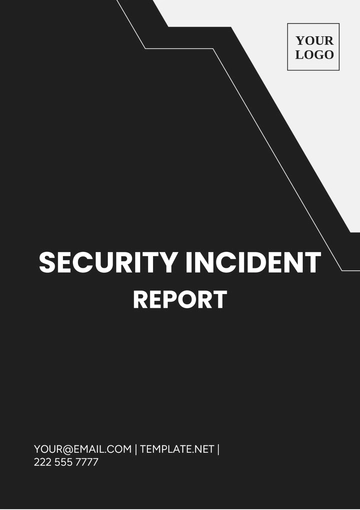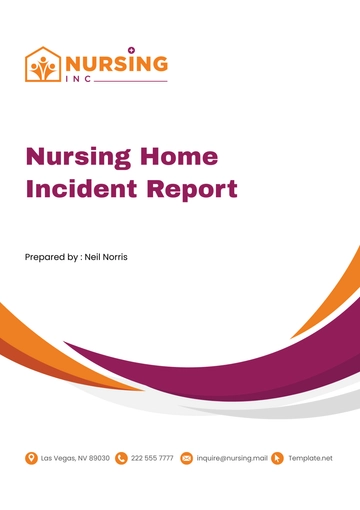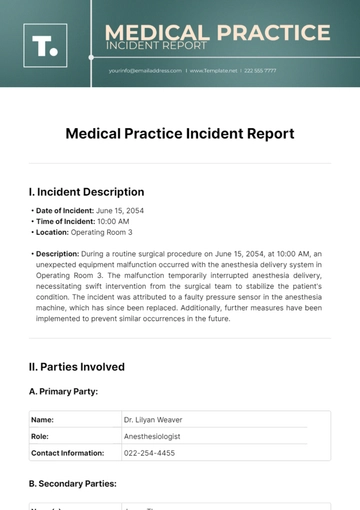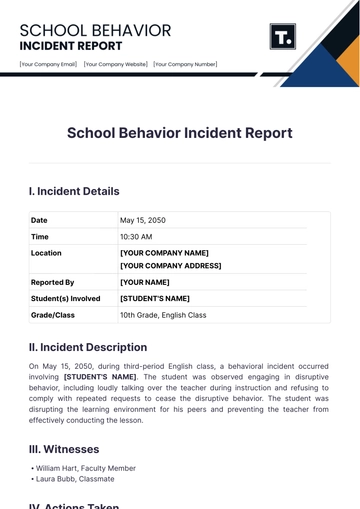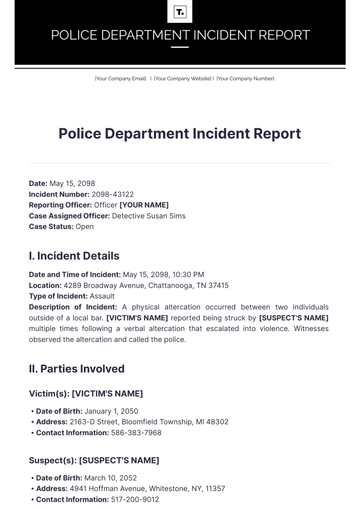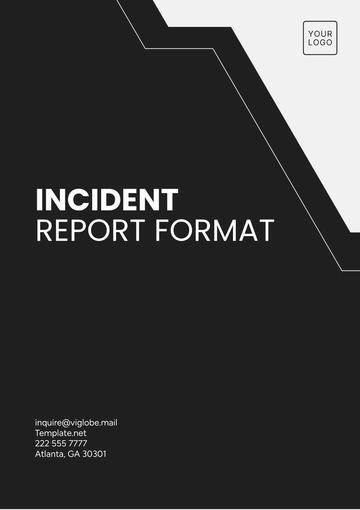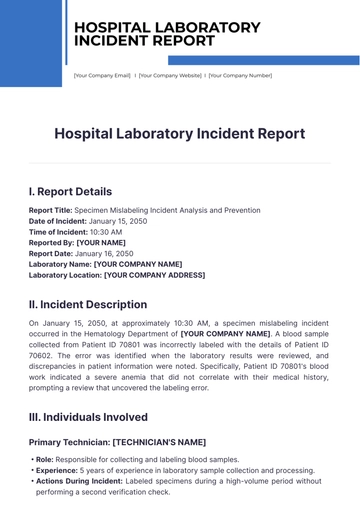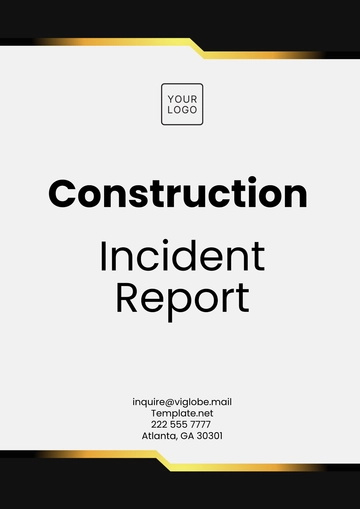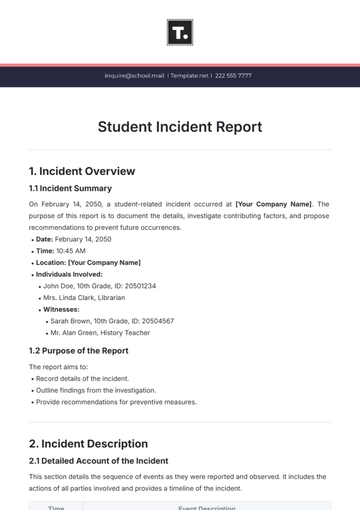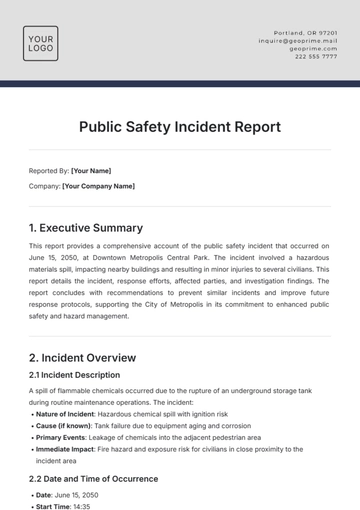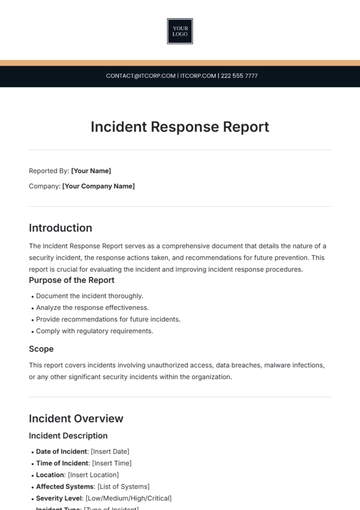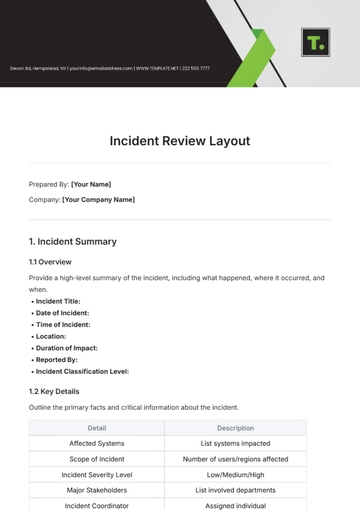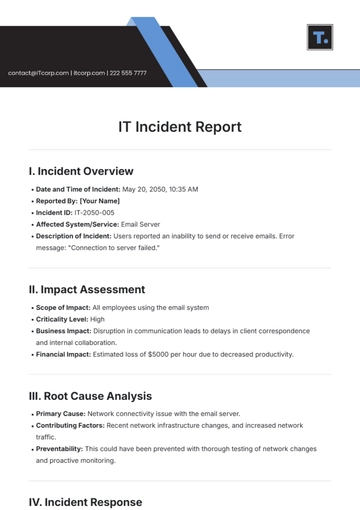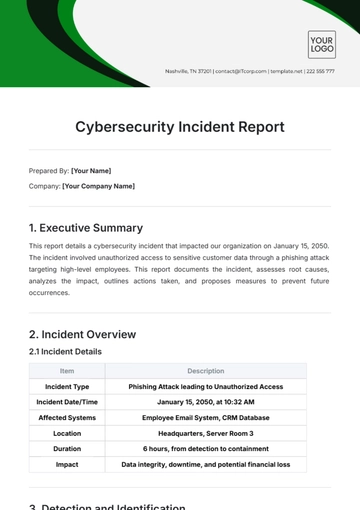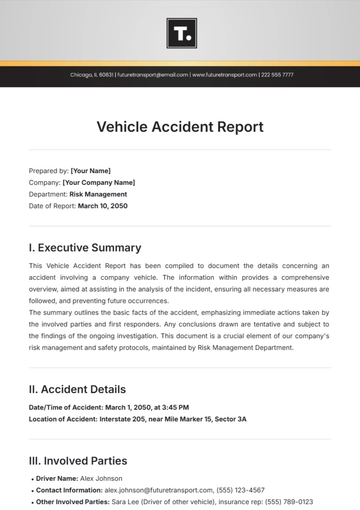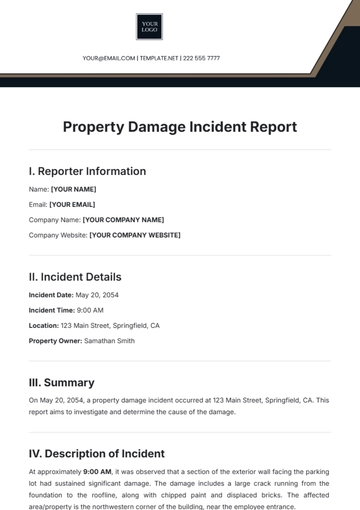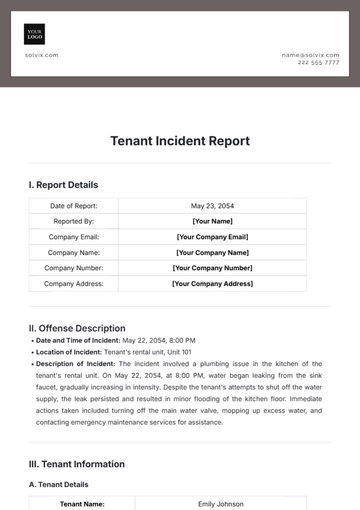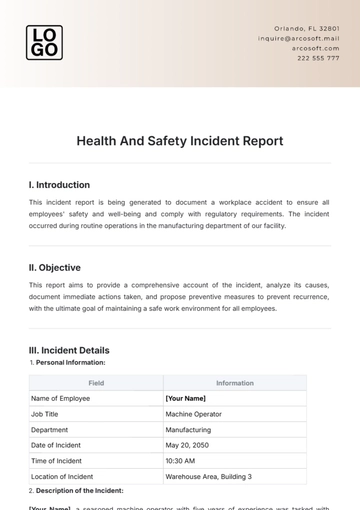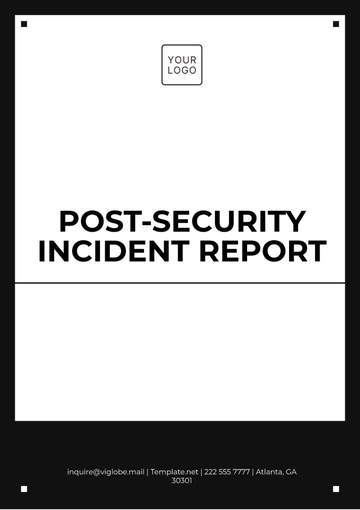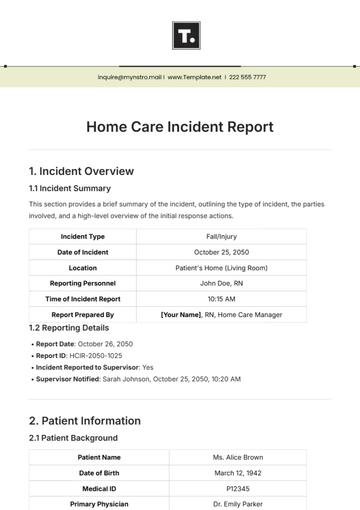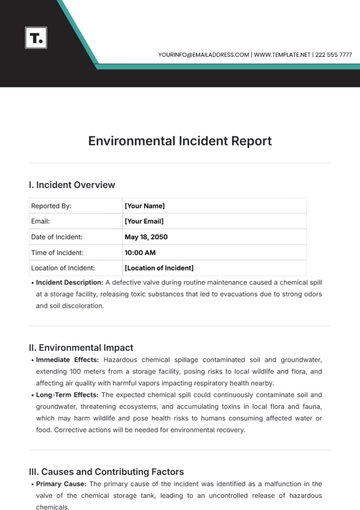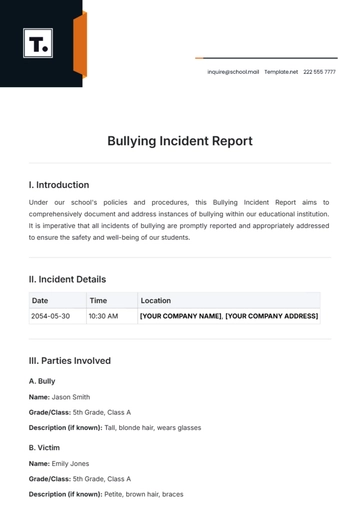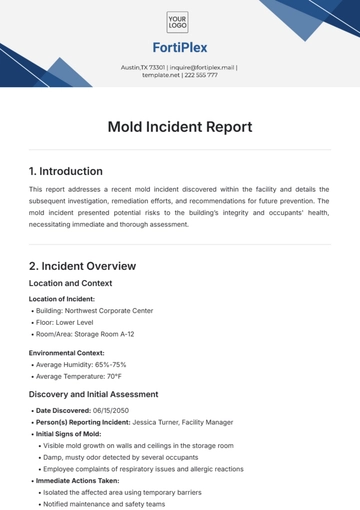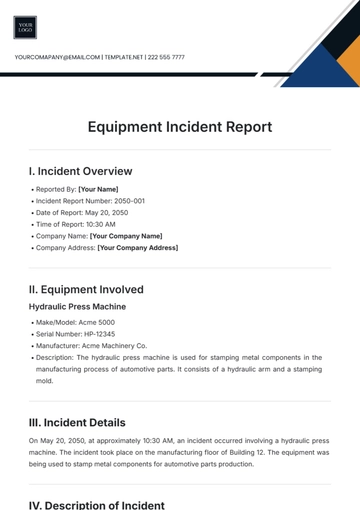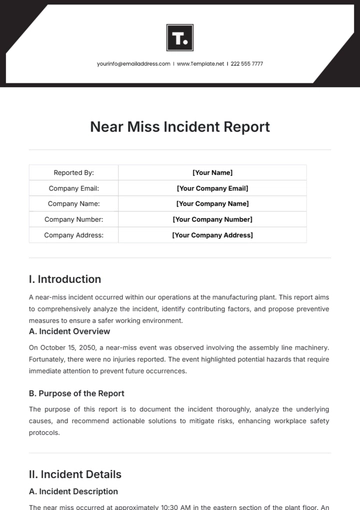Free Pest Control Service Incident Report
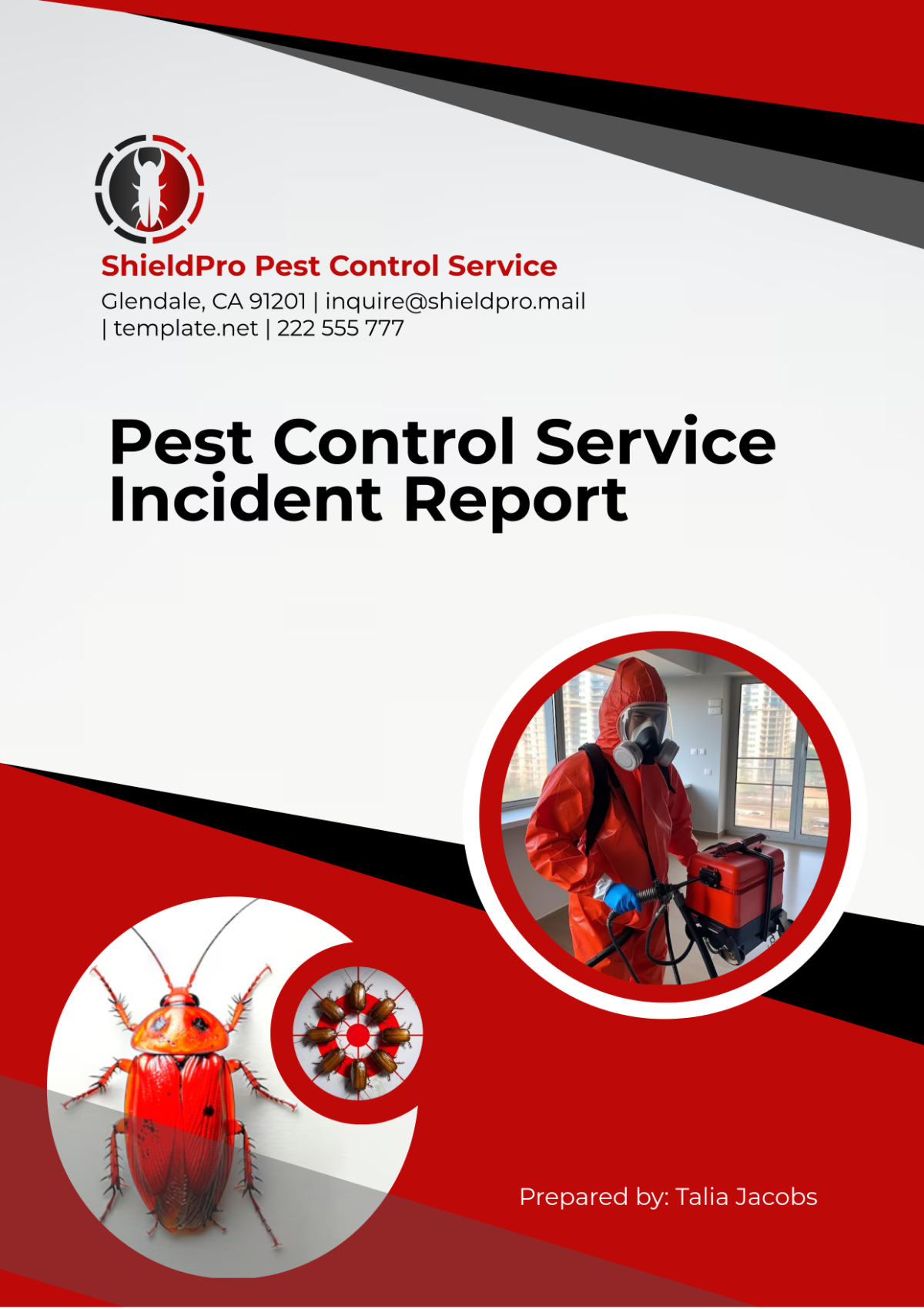
I. Introduction
On [May 12, 2053], a chemical spill occurred in [Warehouse 3]’s chemical storage section at [Your Company Name]. The incident involved the accidental tipping of a container holding pesticide concentrate, affecting a [15-square-foot area]. Three employees—two warehouse staff members and a supervisor—were immediately involved in the response efforts. Prompt containment and safety measures were enacted, preventing any harm to personnel or further spread of the chemical. This report documents the incident response, findings, and preventive recommendations.
II. Immediate Response Actions
This section details the immediate actions taken to contain the incident, ensure the safety of employees, and communicate with relevant personnel.
Initial Containment: Within [five] minutes of the spill, containment barriers were swiftly placed around the affected area to limit the spread of the hazardous material. The barriers effectively secured the area, creating a physical boundary and mitigating further risks.
Evacuation: To safeguard all personnel, individuals within close proximity to the incident were promptly evacuated from the immediate area. Evacuation procedures followed a strict protocol, ensuring that all employees were safely distanced from any potential exposure.
Notification: Following the incident, supervisors were notified without delay, enabling the immediate activation of the emergency response team. The fast relay of information helped maintain control and ensure the effectiveness of the response.
Personal Protective Equipment (PPE): Emergency response team members were equipped with personal protective equipment (PPE) tailored to handle hazardous material spills. The use of PPE ensured that all personnel involved in the containment and cleanup of the spill remained protected.
Ventilation Adjustment: To prevent the accumulation of hazardous fumes and reduce the risk of airborne exposure, ventilation adjustments were made immediately. Exhaust fans were activated, and additional ventilation points were opened to disperse fumes safely.
The swift response was instrumental in containing the spill and minimizing hazards. Effective communication, combined with proper PPE use, allowed the team to manage the incident without injuries or significant interruptions to operations.
III. Incident Details
This table itemizes essential details of the incident, providing clarity on the substances involved, affected personnel, and operational impact.
Detail | Description |
|---|---|
Date and Time | May 12, 2053, 10:30 AM |
Location | Warehouse 3, Chemical Storage Section |
Incident Type | Chemical Spill |
Substance Involved | Pesticide concentrate |
Area Affected | 15 square feet |
Employees Involved | 2 Warehouse Staff, 1 Supervisor |
Operational Impact | Warehouse temporarily closed for decontamination |
The controlled impact of the spill, limited to a small area, was manageable due to quick action. Minimal disruption was reported, with warehouse functions resuming the next day following decontamination procedures.
IV. Investigation Findings
This section presents key findings from the investigation into the incident’s cause, identifying potential oversights and areas for procedural improvement.
Cause of Spill: Investigation revealed that the container was not securely placed during unloading, resulting in the accidental tip-over.
Equipment Inspection: Examination of the equipment indicated no malfunctions or damages contributing to the spill.
Employee Actions: All employees involved followed protocol in evacuating the area and notifying management.
Safety Procedures Review: The investigation highlighted the need for additional training in proper handling and secure placement of chemical containers.
V. Chemical Handling and Safety Procedures
This section outlines the safety protocols established for handling hazardous materials, focusing on prevention measures and adherence to safety standards.
Secure Container Placement: All chemical containers are required to be stored and handled securely to prevent tipping or accidental spillage. Containers must be placed on stable, reinforced shelving designed to accommodate various sizes and weights, thereby reducing the risk of mishandling and spills.
Safety Gear Requirement: It is mandatory for personnel to wear appropriate PPE when handling, transporting, or storing chemicals to ensure complete safety and minimize risk of exposure. This gear includes gloves, eye protection, and face masks, with additional equipment required depending on the substance in use.
Routine Inspection: The chemical storage area undergoes a comprehensive inspection on a monthly basis to identify any potential risks or deviations from storage protocols. This routine check ensures that storage conditions remain secure, that all materials are correctly labeled, and that containers are intact and properly sealed.
Spill Response Kit: A fully stocked spill response kit is maintained within each chemical storage area to enable immediate action in the event of an incident. This kit includes absorbent materials, neutralizing agents, and protective gloves, all of which are essential for managing small to moderate spills quickly and effectively.
Adhering to established safety protocols greatly minimizes the risk of spills. Enhanced focus on secure handling procedures and regular inspections can improve hazard control.
VI. Preventative Actions and Recommendations
This section provides recommendations for enhancing safety and preventing future incidents based on the investigation’s findings.
Enhanced Training Programs: Implement monthly training sessions specifically focused on secure handling and placement of hazardous chemicals to reinforce safe practices and improve staff competency.
Reinforced Storage Solutions: Introduce reinforced and more stable storage shelves for chemicals to prevent accidental tipping. These shelves should be designed to accommodate containers of varying sizes to minimize movement during storage.
Routine Emergency Drills: Schedule biannual emergency response drills for chemical spills to familiarize employees with proper procedures, ensuring preparedness and quick response.
PPE Supply Chain Review: Regularly audit and restock PPE supplies to guarantee that all staff members have access to high-quality, reliable safety gear tailored to the chemicals handled in the facility.
Audit and Oversight Improvements: Conduct periodic safety audits in the warehouse to verify adherence to chemical handling standards and address any emerging risks.
By implementing these recommendations, [Your Company Name] can enhance its safety culture, reduce the likelihood of hazardous incidents, and foster a more secure work environment for all personnel.
VII. Next Steps
The Next Steps section outlines the actions to be taken following the report to enhance safety practices and prevent future incidents.
Schedule Training Sessions: Develop and execute a series of training sessions for all employees, with a focus on advanced chemical handling techniques, proper storage, and emergency response for spill containment.
Inventory of Emergency Supplies: Perform a comprehensive review of all emergency response supplies, ensuring that all spill kits and PPE are adequately stocked and accessible in all chemical storage areas.
Implementation of Safety Audit: Initiate a routine safety audit program specifically aimed at identifying and rectifying any potential issues in chemical handling and storage across all facilities.
Meeting with Management and Staff: Hold a debriefing meeting with warehouse staff, supervisors, and management to discuss the findings of this report, reinforce the importance of safety measures, and encourage continuous improvement in safety practices.
Annual Review of Safety Protocols: Schedule a yearly review and update of the company’s chemical safety protocols to integrate any new best practices, regulatory changes, or insights gained from recent incidents.
The incident was effectively managed with a quick and organized response, emphasizing the effectiveness of [Your Company Name]’s emergency protocols. By pursuing the outlined next steps and recommendations, the company can strengthen its preventive measures, increase preparedness, and continue to foster a safe working environment for all employees handling hazardous materials.
- 100% Customizable, free editor
- Access 1 Million+ Templates, photo’s & graphics
- Download or share as a template
- Click and replace photos, graphics, text, backgrounds
- Resize, crop, AI write & more
- Access advanced editor
Document incidents efficiently with the Pest Control Service Incident Report Template on Template.net. This editable and customizable template is ideal for pest control companies to record incidents systematically. Use the Ai Editor Tool to add specific incident details, dates, and resolutions, creating a structured report that enhances accountability and compliance.
You may also like
- Sales Report
- Daily Report
- Project Report
- Business Report
- Weekly Report
- Incident Report
- Annual Report
- Report Layout
- Report Design
- Progress Report
- Marketing Report
- Company Report
- Monthly Report
- Audit Report
- Status Report
- School Report
- Reports Hr
- Management Report
- Project Status Report
- Handover Report
- Health And Safety Report
- Restaurant Report
- Construction Report
- Research Report
- Evaluation Report
- Investigation Report
- Employee Report
- Advertising Report
- Weekly Status Report
- Project Management Report
- Finance Report
- Service Report
- Technical Report
- Meeting Report
- Quarterly Report
- Inspection Report
- Medical Report
- Test Report
- Summary Report
- Inventory Report
- Valuation Report
- Operations Report
- Payroll Report
- Training Report
- Job Report
- Case Report
- Performance Report
- Board Report
- Internal Audit Report
- Student Report
- Monthly Management Report
- Small Business Report
- Accident Report
- Call Center Report
- Activity Report
- IT and Software Report
- Internship Report
- Visit Report
- Product Report
- Book Report
- Property Report
- Recruitment Report
- University Report
- Event Report
- SEO Report
- Conference Report
- Narrative Report
- Nursing Home Report
- Preschool Report
- Call Report
- Customer Report
- Employee Incident Report
- Accomplishment Report
- Social Media Report
- Work From Home Report
- Security Report
- Damage Report
- Quality Report
- Internal Report
- Nurse Report
- Real Estate Report
- Hotel Report
- Equipment Report
- Credit Report
- Field Report
- Non Profit Report
- Maintenance Report
- News Report
- Survey Report
- Executive Report
- Law Firm Report
- Advertising Agency Report
- Interior Design Report
- Travel Agency Report
- Stock Report
- Salon Report
- Bug Report
- Workplace Report
- Action Report
- Investor Report
- Cleaning Services Report
- Consulting Report
- Freelancer Report
- Site Visit Report
- Trip Report
- Classroom Observation Report
- Vehicle Report
- Final Report
- Software Report
